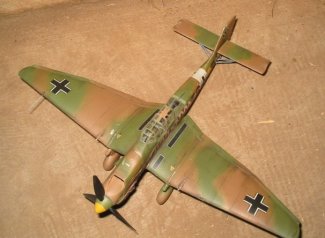History
The
Ju 87 made its first flight on September 17th 1935, but it took two
year for the Ju 87 to roll of the assembly line in Dessau. It took the Spanish
Civil war to give the Luftwaffe the opportunity to test the new aircraft the Ju
87A-1. To the German Luffwaffe the Ju 87A-1 was a success in its achievement on
various missions. At the time of the Spanish Civil war, the Junker Jumbo 210 Da
engine, was powering the Ju 87A-1 giving the capacity of 680 hp barely reaching
the speed of 320km/h. This became a problem for the Ju 87 so a new Jumbo 211A
engine which then delivered 1,100hp was given to the Ju 87 but then a completely
new redesigned fuselage front was in order to take the more powerful engine. The
landing gear also had to be modified in order to eliminate some problems as well
as the rear gunners position being totally redesigned at this stage of the
changes to the Ju 87 a radio was incorporated and the gunner also became a radio
operator. After this the Ju 87 was given a new least of life as the Ju 87B-1
this was the dive-bomber that was first in service at the start of the Battle of
Britain. But there were still a few details that had to be changed to the Stuker
so an other engine was installed the 1,200hp Jumbo 211 Da and a new wider three
bladed propeller and that of a wider exhaust, and in the summer of 1940 the new
Ju 87B-2 went into service, and by 1941 over half of all Stuka units were
equipped with the new Ju 87B-2.
As
the range of the Stuka was still very modest, but the war was moving further
into the Mediterranean and that of North Africa it became apparent to extend the
range of the Ju 87B-2 so they were fitted out with two 300-litre under-wing
reserve tanks. Ju 87B-2 fitted with these were known as Ju 87R-2
(R= range) The Ju 87 was always a controversial aircraft and very well
suited to its intend missions but it was also to too slow, too heavy and a very
easy target for Allied fighter.
When
the Ju 87 was first released back in 1935 it was called the Sturzkampfflugzeug,
which was quickly abbreviated to Stuka by which name it was known to friend and
foe alike.
|
Click on
images below to see larger images
|

|

|
The Kit 04564
This
Kit was released in last two years in Australia form the Revell Germany,
although the kit really is a revamp of the old Hasegawa kit but at a much
cheaper price, so the quality of this kit is to that of Hasegawa’s quality.
The only thing that I have noticed with Revell Germany and that of Revell/Monogram
are the decal sheets for German aircraft never come with the Swastika on the
tail, and I don’t know of a German aircraft that flew in W.W.II that didn’t
have the swastika on the tail.
Construction
This kit was
built OOB apart form the seat belts which were from the Eduard German seat belt
range. The only thing that I have not yet assembled on this kit is the antenna,
which is on the center canopy. The Kit is pretty straightforward to build
however some putty, filing and sanding is required. The most difficult part to
assemble is the nose/cowling with about five pieces needed to make the nose of
the Ju 87, and that I found it to be very fragile to sand away the seem lines.
But the rest of the kit went together quite easy. The cockpit is well detailed
apart from seat belts but then there are a few people on the ARC site that have
stuck resin cockpits into there Ju 87 and I must admit they look fantastic.
Apart from that I enjoyed building this kit and look forward to building an
other one.
Painting
and Finish
I painted
this model using Revell and Humbrol paints with some slight chipping of the
paint to give a used effect once the decals were placed on taking a swastika
form a left over Fw 190 kit, for the Ju 87, I gave the model a gloss clear cote
followed by a matt clear and then a pastel wash for the grubby effect, and then
another cote of matt clear to seal in the pastel wash. This Ju 87 is made up to
represent the Junker Ju 87 B-2, 6./St.G. 2, Tmimi/Libyen, June 1941.
Alan
|
Click on
images below to see larger images
|

|

|
|